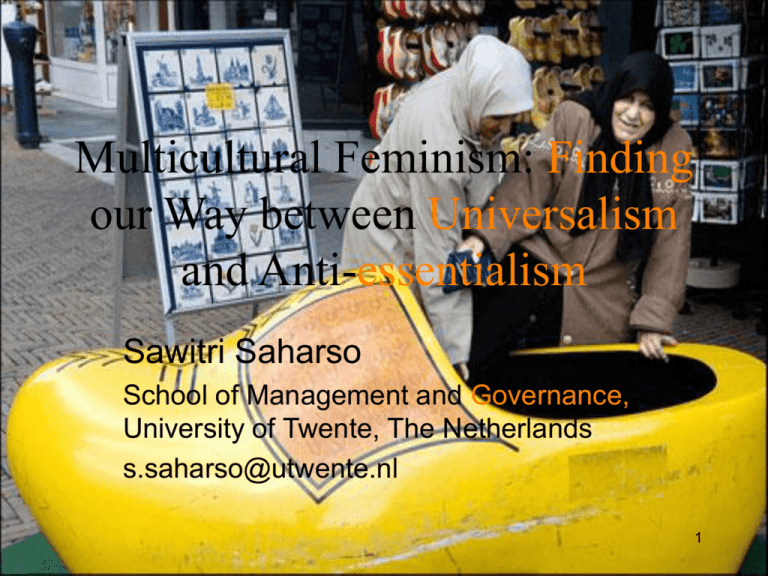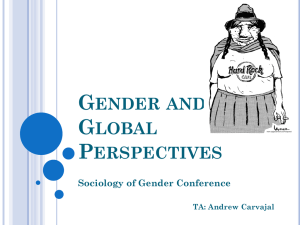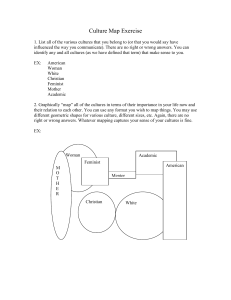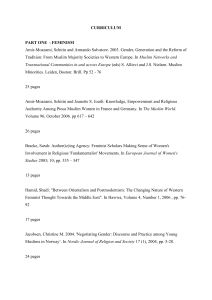Multicultural Feminism: Finding our Way between
advertisement

Multicultural Feminism: Finding our Way between Universalism and Anti-essentialism Sawitri Saharso School of Management and Governance, University of Twente, The Netherlands s.saharso@utwente.nl 1 Is Multiculturalism bad for women? • Susan Moller Okin (1999) • Many of the cultural minorities that claim group rights are more patriarchal than their surrounding cultures. Cultural group rights can then function as a licence to oppress minority women • Feminism vs. Multiculturalism debate • Minorities within Minorities debate 2 Responses • Genealization: absurd to refer to one Middle Eastern culture (S. Benhabib) • Western regimes simply “less patriarchal” than other regimes, rather than worse in some respects and better in others (Honig) • Non- western women as misguided victims who need to be rescued by Western feminists (A. Al-Hibri, B. Parekh) 3 Intercultural dialogue • Risk we use double standards • Risk we use essentialist notions of culture • Risk we speak for and thereby deny the autonomous agency of minority women • Shut up? • Explore: is it possible to speak across cultures? 4 Is feminist solidarity across cultures possible? • Structure of the lecture: • Sketch political landscape in which the discussion takes place • Use female genital cutting as a case to discuss: Cultural respect, autonomy and feminism across cultures 5 What is the relationship between gender and culture? • Culture as a pretext for women’s oppression: ‘my culture made me do it’. • Cultural prescriptions limiting women’s freedom may be functional for the preservation of of the minority’s culture: - biological reproduction controlled by family law - Rules for women as a marker for group identity - Under conditions of inter-group dynamics: when group boundaries become politicized, it 6 is usually at the expense of women Gender relations as a group marker for dominant culture • The message of Paul Scheffer’s ‘The Multicultural Drama’ (2000): apartheid is imminent • Because of the rise of an economic underclass • Because that underclass does not respect liberal egalitarian values 7 Paul Scheffer: “Tolerance must be defended against religious coercion. There should be no place in public life for movements opposed to the separation of church and state or equal rights for men and women. Religious symbols such as headscarves belong in private life and not in official bodies like the police force” 8 Pim Fortuyn • Islam is a backward culture • Well-educated Islamic young women leave their sisters in the cold: “... putting on a headscarf out of some kind of protest. Hang it on the willow trees and see to it that your sisters get their rights” (De Volkskrant Feb. 9 2002) 9 Wouter Bos leader Labour Party and vicechancellor • Issues that tear society apart, like ‘integration’ should not be stifled • It is about morality. Where do you stand? And to dare to say so. • I find it important that the Cabinet has said no to the burqa and forbids it because of public order. Of course I know it only concerns 150 cases in the Netherlands. What counts is to set a norm. (De Volkskrant March 1 2008). 10 Feminists join the debate • Ciska Dresselhuys chief editor feminist magazine Opzij: “[I] as a feminist want to offer help to those Muslim women who in their hearts very much would take off the symbol of their inequality – the headscarf – but who (as yet) do not dare that. That is the least that these women may expect from me.” (Opzij, April 2001) To explain her refusal to hire an editor wearing a headscarf 11 Ayaan Hirsi Ali “(I am convinced) that the emphasis on a Muslim identity with corresponding “group rights” is detrimental to Muslim women”. “Muslim women in the West will benefit more from the dominant Western culture” (Hirsi Ali 2006, p. 6) 12 Evaluation intervention Hirsi Ali Mixed blessing: • Put issues like honour killing and FGM on the political agenda • But alienated herself from many of the Muslim women for whom she claimed to speak • By suggesting that emancipation is only possible by rejecting Islam, her intervention did not create more space for Muslim women to develop and express as Muslimas their ideas on emancipation. 13 Back to Europe “The degree of civilization of a society is ultimately measured by the place women occupy.” Former French president J. Chirac, December 17 2003 Governments across Europe more active in tackling gender inequalities within minorities Went together with retreat from multiculturalism and growing Islamophobia 14 Consequences for feminism across cultures • Gender relations are used to mark group boundaries • Both by minority and majority groups • Combined effect: • Hampers minority women to emancipate on their own terms • Hampers feminist coalition-building across cultures • We must be wary that a feminist agenda not be hijacked by anti-multiculturalists. 15 Battlefield: Female Genital Cutting All procedures that involve the partial or total removal of the external female genitalia or other injury to the female organs for cultural or other non-therapeutic reasons (World Health Organization 1999) 16 What’s in a name? • Female circumcision • Female genital mutilation • Female genital cutting 17 Facts • Practiced mainly in Africa; in at least 28 African countries, but also in Asia and Middle East • Mainly in Islamic countries, but not prescribed by Islam • A women’s affair: victims, carrying out the procedure, mothers authorizing it • Generally repudiated as human rights violation, but difficult to ban 18 Why do women practice fgc? • Religious motives: believed to be religiously prescribed • Health factors: fertility, virility, health baby • Hygienic motives: female genitals considered as unclean • Ethnic interest: promoting identification with cultural group • Socio-economic reasons • Gender related reasons: fe/male identity 19 Why do we think it is wrong? • Gender discrimination • Autonomy • Harm • Bodily integrity Policy objectives: • General ban • Ban for children, allow consenting adult • Ban mutilating forms, allow nonmutilating forms • Idem 20 Dilemma: Eradicate the practice and respect women’s choices • B. Parekh: accept voluntary choice • M. Friedman: • Distinction substantive and procedural conception of autonomy • Substantive: focus on content of choice • Procedural: how did choice come about? 21 2 advantages • Focus on context of choice: less risk of cultural bias • Recognise the autonomy of women living under oppressive conditions: “However oppressive their conditions might be and however much change is morally required, traditionally subordinate feminine lives nevertheless can and do often nonslavishly embody and express values worth caring about.” (M. Friedman 2003, p. 25). 22 FGC and Breast Implants • Social norms can make it rational for individuals to want things which profoundly threaten their well-being (C.Chambers 2004) • No need for assumption FGC practising women are non-autonomous or FGC forced choice • Solution: not to educate women, but to alter the social circumstances which stimulate the harmful practice (see Tostan project) 23 Intercultural conversations: who has the right to speak? ‘Much of the ‘anti-FGM discourse’, as currently formulated, overly homogenizes diverse practices, is locked in a colonial discourse that replicates the ‘civilizing’ presumptions of the past, and presents a universalized image of female bodies that relies upon particularized assumptions of what constitutes ‘naturalness’ and ‘normality’. W.N. Njambi (2004) 24 Let us acknowledge: • In 19th century America clitoridectomy as a ‘cure’ for hysteria, nymphomania, lesbianism and excessive masturbation. • Trimming: normalizing ambiguous female genitalia • Cosmetic surgery and rise of the ‘designer’s vagina’ in US and Europe 25 A colonial civilizing discourse? ‘Can the mothers of these girls make an informed choice as to the value of female sexual pleasure? They have been immersed in traditional beliefs about women’s impurity; lacking literacy and education, as a large proportion do, they have difficulty seeking out alternative paradigms. … their situation is made more difficult by fear and powerlessness. … they are highly likely to have experience marriage and sexual life as a series of insults to their dignity, given the ubiquity of domestic violence and marital rape. Should they believe that FGM is a bad thing for their daughters … they have no power to make their choices effective’. M.C. Nussbaum (1999) 26 What then? Stand by and watch? • Political paralysis. (K. Davis) • Silences women who experience FGC as violence. Are they part of western discourse? (C. Castenada) • If I reject FGC is that because I am an outsider, black yet not African-based? (M. Henry-Waring) • Moral outrage also motivated by empathy and desire to accept resonsibility to fight domination of women globally (K. Davis) 27 Conclusion “To say that a practice endorsed by tradition is bad is to risk erring by imposing one’s own way on others, who surely have their own ideas of what is right and good. To say that a practice is all right whenever local tradition endorses it as right and good is to risk erring by withholding critical judgement where real evil and oppression are surely present. To avoid the whole issue because the matter of proper judgement is so fiendishly difficult is tempting but perhaps the worst option of all.” 28 (Nussbaum 1999) Cross cultural coalitions: tools • Cross cultural comparison • Contextualized analyses Examples: • Prostitution and Sex Selective Abortion: “their own choice”? • Bimbo culture and honour killing 29 Bridging Cultures: a third wave? Immigrant and native women, Muslim and non-Muslim women, together challenge both conservative-religious ideas on female sexuality and the libertine raunch culture as the “excrescences of the same symptom, namely that women are still attempting to meet the norms of chastity, sexuality and beauty imposed upon them by men.” Stine Jensen & Çilay Özdemir, Together against honour killing and the slenderness ideal (Samen tegen eerwraak en slankheidsideaal) (NRC Handelsblad, May 2, 2007). 30










